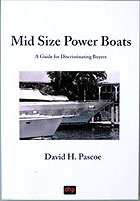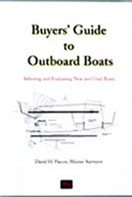Top Twenty Design & Construction Faults
Updated for Y2K
by David Pascoe
Our web site has been up for over four years now, and as time passes, some of the information gets dated. So, it's time to update one of our most popular pieces, The Top Twenty five Design Errors.
I've changed the name to Top Twenty because I'm no longer including the sailboat information as we have limited ourselves to powerboat surveys only. So, here we go.
- 1. Badly made deck-to-hull joints
- 2. Sealed off hull compartments
- 3. No structural bulkheads
- 4. Low quality plywood used for hull structural members
- 5. Plywood structurals such as stringers and frames painted with gel coat
- 6. Improper aluminum fuel tank installation
- 7. Interior cabin soles build just a few inches above the bottom of the hull
- 8. Badly designed engine hatch gutters, or no gutters at all
- 9. No gutters on rope locker hatches
- 10. Non insulated air conditioning ducts
- 11. Improper mounting of steel chassis electrical devices
- 12. Leaky cockpit decks
- 13. Improper design or installation of center consoles
- 14. Improperly designed generator exhaust systems
- 15. Chine walking and loss of steering control
- 16. Poor low speed handling
- 17. Weak, unsupported hull sides
- 18. Sensitive electrical devices installed in exposed locations
- 19. Poor gel coat finishes
- 20. Large cockpit seating modules on top of large electrically opened cockpit deck hatches
Top Twenty Design & Construction Faults
1. Badly made deck-to-hull joints.
Leading the pack of serious faults is badly made deck-to-hull joints. So much so that I have a dedicated article dealing with this rather complex subject. When buying a new or used boat, it pays to research this issue carefully. Read the article and you'll find out why. Related Article: Hull to Deck Joint (at www.docksidereports.com )
2. Sealed off hull compartments
Meaning that the new trend in boat building is to eliminate all access to areas of the internal hull. This often results in compartments between stringers and bulkheads that are sealed off by the cabin sole. If water leaks into these compartments, this can result in filling up with water and cause deterioration of structural hull members such as stringers and bulkheads. Related Article: Why Internal Hull Areas Should Be Accessible
3. No structural bulkheads
No structural bulkheads still leads the list of major engineering faults of small cruisers that aspire to provide a cavernous interior, uncluttered by nuisances such as things like bulkheads and other structural hull members. We continue to find many small boat interiors breaking apart due to tortional hull twisting. And poorly supported fore decks that, when you jump on them, the port holes or windows pop out, due to a complete lack of framing or support that bulkheads would otherwise provide. What appear to be bulkheads are usually just partitions, space dividers that are not attached to the hull. Related Articles: Hull Design Defects Part I | Hull Design Defects II
4. Low quality plywood used for hull structural members
Some of the plywood material we see used in many of the most popular entry-level boats is the lowest quality plywood available. Absolutely the bottom-of-the-barrel stuff. It's rough with exposed knots and lots of voids in the plies, all of which allows water to get into the wood with the inevitable results. Related Article: Preventing Rot in Encaplulated Wood Structures
5. Plywood structurals such as stringers and frames painted with gel coat
Many builders are trying to make it look like their stringers and such are glassed over when, in fact, all they have done is to paint a heavy layer of gel coat on them. Since you already know that gel coat is very good at absorbing water, the plywood also absorbs water, swells up and causes big cracks in the gel coat. Then the plywood absorbs even more water. Related Article: Preventing Rot in Encaplulated Wood Structures
6. Improper aluminum fuel tank installation
You'd think by now, after all these years of terrible fuel tank problems, builders might be a little more careful about this. But, no, we find even the likes of Sea Ray doing a bad job of it. There is no excuse for mounting an aluminum fuel tank on a plywood deck that will come in contact with bilge water. Related Article: How to Install an Aluminum Fuel Tank
7. Interior cabin soles build just a few inches above the bottom of the hull
You'll find this on nearly every small, so-called "aft cabin" cruiser. With no space beneath the deck to mount a bilge pump, and the only pump located in the stern, the end result here couldn't be more predictable.
8. Badly designed engine hatch gutters, or no gutters at all
A few builders have gotten better at making engine hatches capable of keeping water off the engines. Others haven't. An engine hatch must absolutely be capable of keeping water off the engine, otherwise, you pay a high price for corrosion damage and the potential for engine failures.
9. No gutters on rope locker hatches
We see numerous cases where an anchor windlass is installed with the drive motor being located in the rope locker that has no gutter. This lets salt water cascade directly onto windlass motors and associated electrical components, bringing on an early and costly demise to these expensive components.
10. Non insulated air conditioning ducts
Sweating ducts drip condensation onto plywood components causing water damage. A/C ducts must be insulated.
11. Improper mounting of steel chassis electrical devices such as water heaters, battery chargers and power trim motors.
Usually mounted on a flat deck that collects and retains water, these items then quickly rust out because they are constantly sitting in water. This is often aided by water heaters that have no drain hoses attached to the pressure relief valves which drain water onto the base that the heater is sitting on. Battery chargers mounted near hatch openings so that these get wet.
12. Leaky cockpit decks
Particularly in the mid to large size express cruiser class. Components like seating modules are mounted in cockpit decks by putting bolts through cored decks. Or holes are thoughtlessly drilled through the decks that allow water in. In one case, the large hatch gutters angled forward while the drains were located aft. Wet the deck and gallons of water would pour into the engine room of a $300,000 boat. Related Article: Deck Leaks
13. Improper design or installation of center consoles
Numerous instances of consoles screwed down to cored decks. Consoles break loose or water gets into deck core.
14. Improperly designed generator exhaust systems, particularly in sport fishermen.
Transom outlet allows water to be pushed back through exhaust and into engine.
15. " Chine walking and loss of steering control
At high speed, boat lays over on its side. Trim tab inputs result in extreme and unwieldy responses. The causes of this are complex, but well known. The main reason this occurs is that the designer didn't know what he was doing, and the builder didn't bother to test the performance, or bother to correct the problem. He gets away with this by ascribing the problem to "operator error." Large numbers of boats are affected with this problem. Related Article: Chine Riding.
16. Poor low speed handling
Usually caused by propeller pockets and very small rudders, there is nothing to steer the boat. The current trend in placing engines and propellers very close together-- in many cases engines almost touching each other -- results in poor handling at any speed, and also contributes to chine walking. The reason for this is to achieve greater interior space, sacrificing interior amenities for performance, hence the term "floating condo."
17. Weak, unsupported hull sides
In the never-ending quest to increase profit margins, the concept that hull sides should have framing or some means of support to prevent panting or panel deflection has been thrown out. Panting or buckling hull sides contributes to problems at the deck/hull joint, particularly if it is only screwed together. Hull side panting also results in stress cracking, leaking port holes and frequently severe problems with interior attachments, such as cabinets and galley modules going adrift. Related Article: Screw It!
18. Sensitive electrical devices installed in exposed locations
They include panels, switches and main shore power circuit breakers. Unskilled designers are taking increasing liberties with installing electrical apparatus in locations that get wet and result in water damage and system failures. You pay the cost for this ignorance. Related Article: Electronics Outside
19. Poor gel coat finishes
Despite the claims of manufacturers, gel coat finishes have gotten no better, and in some cases worse. Example: a one year old 40' Formula where the finish luster was completely gone. It's time to give up on gel coat and start painting boats with linear urethane like Hatteras does.
20. Large cockpit seating modules on top of large electrically opened cockpit deck hatches
This is turning into an unmitigated disaster. Engine compartments that only open two feet, making engine room access and servicing extremely difficult and physically painful. Tiara is one of the worst offenders. This kind of design should stop as it is seriously driving up the cost of servicing and ownership.
Hint to designers: Here's a great place to put those ultra light, high tech composites to work. Make the seating modules ultra light. Then put nylon runners on the bottoms so that they can be slid (not carried) off the hatches, without scratching the deck, so that the hatches can be fully opened. Do us a favor and put the pleasure back in boating. Related Article: Recent Design, Construction and Materials Improvements - 1996-2000 Models
Posted July 12, 2000

















David Pascoe is a second generation marine surveyor in his family who began his surveying career at age 16 as an apprentice in 1965 as the era of wooden boats was drawing to a close.
Certified by the National Association of Marine Surveyors in 1972, he has conducted over 5,000 pre purchase surveys in addition to having conducted hundreds of boating accident investigations, including fires, sinkings, hull failures and machinery failure analysis.
Over forty years of knowledge and experience are brought to bear in following books. David Pascoe is the author of:
In addition to readers in the United States, boaters and boat industry professionals worldwide from nearly 80 countries have purchased David Pascoe's books, since introduction of his first book in 2001.
In 2012, David Pascoe has retired from marine surveying business at age 65.
On November 23rd, 2018, David Pascoe has passed away at age 71.
Biography - Long version